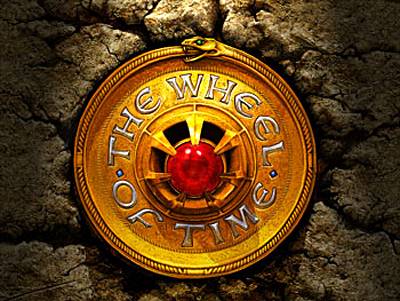
The Wheel of Time is a fantasy, first person shooter for the PC based on the best-selling series of books by Robert Jordan. It was one of the first games to license the then-new Unreal engine, and leveraged that technology to deliver a compelling single-player story and unprecedented multiplayer experience.
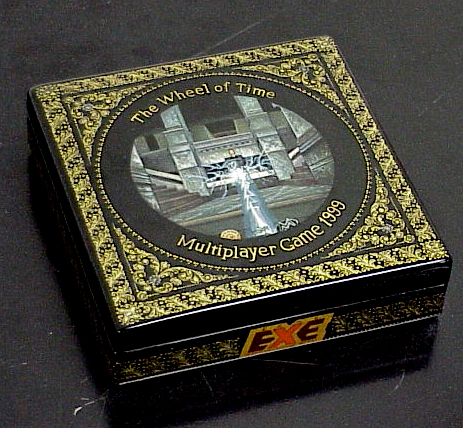
Released in 1999, although it didn’t break into the public mindspace as much as its contemporaries Quake III Arena and Unreal Tournament, it was well reviewed and received multiple awards–including Gamespy’s Action Game of the Year and its recognition as one of the most underrated games of all time.
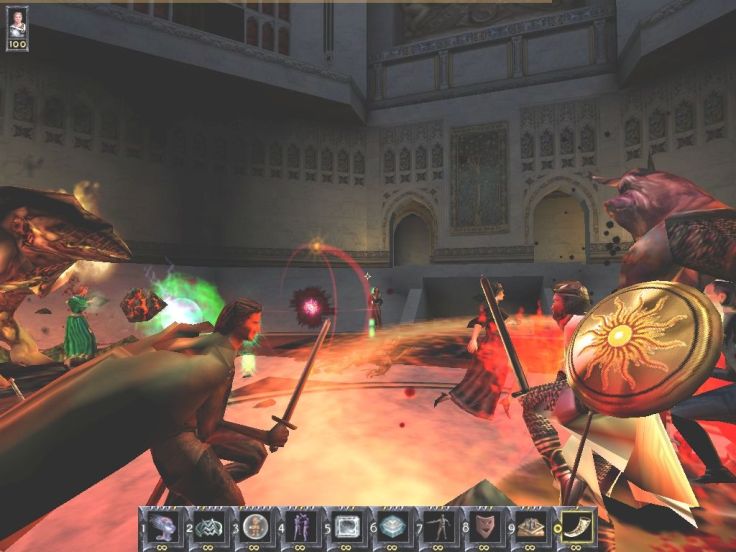
The Wheel of Time is the game I’m the most proud of. After its release, I played it. A lot. There aren’t a lot of my own games I can say that about, because after spending months or years with a game, you kind of want to leave it behind. But in WoT, I found it fun to compete with other fans–so much so that I anonymously joined an elite clan of WoT players under the names GreenHornet and OneEye (the rather stupid joke was that I was the one-eyed man in the land of the blind, I was so good).
That lasted a few months until they got much better than me. Which is why I needed more pseudonyms, because I didn’t want to get embarrassed when I lost. Badly.

In the following video. you can see a game of arena. Here are some things to note: 1) The bell tolls when someone dies, 2) You hear a ‘ting’ sound when a seeking spell has locked onto you, 3) Players are using defenses to swap places or reflect to avoid seeking spells, or they put up auras of anti-magic to kill everything floating in the area.
Because of its multiplayer modes (especially Citadel), the Wheel of Time is still played to this day. There are facebook groups dedicated to it. Over the years, fans have tried to recreate the game in the most current Unreal technology.
The support is humbling.
Ancient History
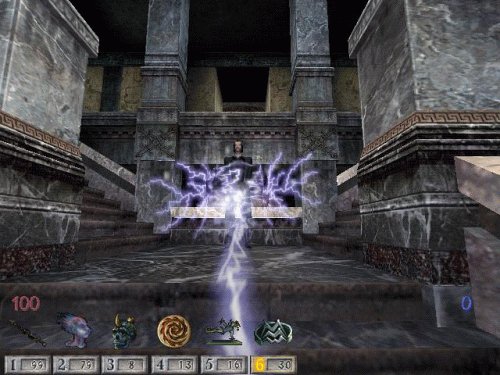
Back then, the Wheel of Time was a critical project for Legend Entertainment Company. It transformed us from a fairly niche adventure game developer into a top tier first-person shooter production house. That wasn’t easy, and many many people said it couldn’t be done.
Even me, at times.
But I don’t think I’ve even been more passionate about getting a project made than this game. I fought for it in pitches, in boardrooms, in public with the fans, and in the trenches with the team. The design in my head was impossible to build–especially for Legend–and yet I somehow convinced people to give us money to do so.
I’ve already chronicled the story of how we sold the idea and started that arduous process on the long defunct WheelofTime.com. Now I’m dredging it back up, but with two new (bonus) sections at the end that were cut at the time for being too sensitive. It’s not a small read, nor for the faint of heart, but worth the time.
Now, reprinted here, is the Story Behind WoT.
Part I: The Idea
Through Death’s Gate

Settle in as I take you back to 1994. At that time, Legend Entertainment Company focused almost exclusively on adventure games. We had a comparatively strong line of them, but they sold to a niche market. Success was measured in tens of thousands of sales, instead of hundreds.
Legend took a few steps to make our games more appealing. First, we went to an entirely graphic interface, completely eliminating the text-based parser that had defined our earlier releases. Second, we tried to attach popular science fiction or fantasy licenses to our games, since the people who played them tended to be fairly literate. The first game to do both of these things was Companions of Xanth, based on the best-selling series by Piers Anthony.
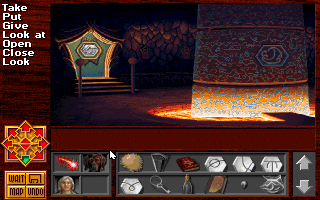
Our following release was Death Gate, my first solo project. It was based on the Death Gate Cycle books from Margaret Weis and Tracy Hickman. It used the graphic interface that we developed for Xanth, and even brought it to Super VGA (the cutting-edge graphic standard at the time).

Legend wasn’t a huge company. The development team consisted of only a few people, supplemented by free-lancers: a bitch to manage, but it cost less in the long run. At the end, we produced the entire game for less than $300,000. You couldn’t even get an opening cinematic for that nowadays.
Towards the end of Death Gate, I had holed up in a hotel room a short drive away from the barn that we were using for a voice-recording studio. During the day, I’d direct the actors to read the lines from the game. And through the night, I’d fix bugs on the system that I’d brought with me. Lack of sleep, overwork, and weeks spent away from everything I knew took its toll. I became paranoid. I got sick. I almost completely collapsed.
When I finished that game, I swore that I’d never go through such hell again (something I swear every time I finish a game). I think my cat has only recently forgiven me for that period.
Coming out on the Other Side

I turned my brain off for a couple of months after that project, during which I played two games that influenced me a lot: Multi-player Doom and Magic: the Gathering. I’m sure you’re familiar with Doom, and M:TG is a collectible card game that involves lots of spells—both offensive and defensive. I was fascinated with both, and knew that there had to be a way to bring them together (and, even after all of the mess that was WOT’s development path, you can make the argument that WoT successfully combined elements from both).
One evening at home, I found myself staring at a popular computer game magazine cover. It went out on a limb and declared that dedicated on-line multi-player games were going to be popular. Of course, it did so many years before anyone could actually make a profit on them, but practicality never stopped magazines from trying to create their own trends.
I was staring at this magazine, and I tried to envision what a multi-player adventure game would look like. You could have puzzles that could require more than one person to solve. You could have people chatting with each other, examining the clues and figuring out the next solution together. You could have a meaningful, non-violent way for people to interact as they worked towards a common goal.
You’d have a huge mess. Hell, it’s tough enough to get an NPC to do what you want to solve a puzzle. Can you imagine having to convince a human boneheaded partner to work with you? One that decided to drop off-line the first moment he got frustrated? Or worse, you’d find yourself with a 14-year old KeWL D00D who suddenly decided that it would be more fun to actively work against you. Even in a best-case scenario, the game’s pace alone would be agonizing.
But, wait a second. What if we put these people at odds, so that they’d be working against each other anyway, like in Doom? But we’d give them a world like an adventure game, with beautiful environments, believable, autonomous characters who could inform on, lie to, or be hired to kill your opponents. And we’d give the players fortresses that they could defend with troops and traps. And we’d let them use a ton of spells against their enemies, like in M:TG.
This was sounding good. Maybe I would make another game.
Convincing the Suits
I walked into the restaurant with a fistful of notes and diagrams for the weekly development lunch. After everyone returned from the Italian buffet, I laid out my plans.

This new game would mix elements from Doom, Magic, and an obscure board game called Wizwar (this game put up to four Wizards into a random dungeon where they tried to steal each other’s treasures). It would create a world where people could truly play roles, a world that felt like the player was walking into a piece of fantasy fine art. They would control networks of spies. They’d use powerful spells to destroy their opponents. They’d customize their home fortresses, and invest themselves in the game before it ever began. My passion for this dream was undeniable and the idea was sound. People liked it, including management. I had taken my first step.
I’d only get the one step, though. Legend was acquired by Random House, a book publishing firm with a clear agenda: make low-cost adventure games based on book licenses from their stable of authors. They didn’t understand this Internet thing. They didn’t even understand multi-player. What they understood is that they bought an adventure game house, and that’s what we’d damn well produce.
They presented me with a list of licenses. I bit the bullet, put my design on the back burner, read it, and found a bunch of names I either didn’t know or wasn’t interested in. Crap. At least, if I was going to make another adventure game, I’d like to be working on something for which I had a passion.
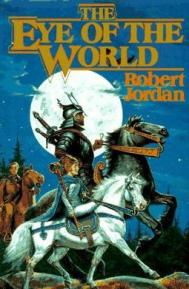
Luckily, within the last year, someone gifted me with The Eye of the World, the first of Jordan’s Wheel of Time novels. I consumed the rest of the series shortly thereafter. Even if it was a long shot, I asked the Random House folk if a game based on his work would be possible.
I caught the little glint in their eyes. After all, pursuing this license would give them a chance to approach Jordan, perhaps eventually convince him to join their label. Naturally, given his wife’s position at Tor, I found this rather unlikely, but I was glad for the opportunity. I sincerely loved his work, and thought his world would make a wonderful game.
We agreed to give him a call.
Part II: Write What You Know
Now how much would you pay?

Yes, Jordan was interested in a computer game based on his world—but we weren’t the only ones asking. Sci-Fi hack-master Byron Preiss (responsible for such atrocities as The Martian Chronicles Adventure Game, Westworld 2000, and Robot City) was looking to add Jordan to its list of unfortunate authors. If you ever doubt our take on Jordan’s work, go play those games, then sigh in relief.
We ended up in a bidding war, but it didn’t last long. Our competition went looking for cheaper fare, and we started designing a game. And, in case you weren’t paying attention, this masterpiece was going to be an adventure game.
But I don’t think anyone told Jordan.
This is My Story…
My fate was decided. I had a clear directive to produce an adventure game based on Jordan’s first book (the only one we had the rights to). So I did some heavy thinking.
Our license was fairly limiting, but I had done this kind of thing before. There are a few rules that I derived from my experience. First, people want to play the main characters from the books, and they want to interact with all of the other characters that they know. Second, they want to bring forth world-shaking events, saving the universe and what-not. It’s just not as satisfying being the guy who helps someone save the world. Who remembers him?
With Death Gate, I managed to retell the entire story of the series of novels. By necessity, I skipped tons of material, I consolidated characters and events, and I changed some fundamental elements—but the result took the player to all of the book’s worlds, told an epic tale, captured the essence of the series, introduced the players to everything without requiring previous exposure to the books, and was ultimately pretty satisfying. I decided to apply this tactic to WoT.
Thank God it didn’t take. As I’ve learned from my experience making a game that is a prequel to the books, which—for its genre—does a credible job staying faithful to its source material, I would have been crucified for the original adventure game. I was retelling the tale. I was using original characters. I changed things! I finished the story with a confrontation between Rand and the Dark One!
What the hell was I thinking? Maybe the design came from a conceit born of making a license fit into a game, the power that comes of using a license as a paintbox, but not a roadmap. Maybe I wanted to write my own story (which, naturally, is true, and necessary in designing an adventure game).
The truth is that this was what I knew. I took my rules and tried to make a compelling and satisfying experience. Hell, forcing the game to follow the book’s plot directly would produce the most predictable game possible. Is that fun?
Regardless, I now know that a Death Gate-type game would have caused massive coronaries in the WoT community. When people heatedly debate the color of a sword hilt, they would have little patience for major changes in character and story.
The Three D’s of Adventure Gaming
Hindsight is 20/20. At the time, a produced a full-up concept document that described the overall story, then sent it to Jordan. While we waited for a response, I had to keep working in order to stay on schedule.
As you see in the concept document, I decided to use a 3D engine. True, real-time environments were too compelling to ignore. If I couldn’t bring my passion to life, at least I was going to bring Jordan’s world to life in true 3D.
Wanting to make a 3D engine and actually doing it are two different activities. One is cheap and fun. The other will make you hate life. Although Legend has some sharp technical people, we’ve always been known for content, not technology. Building a new engine, especially with the kind of time and money that Random House was willing to expend, was a virtual impossibility. But that didn’t stop me from trying.
I did what anyone would do in my position: I looked for a ringer. Combing the net produced a name and an engine: Jaimi McEntire with his 4DX workhorse. The engine’s quality was on par with Doom and BUILD, but I hoped that with significant work, Jaimi could forge it into what I needed, and I needed environments with a lot more complexity than I saw.

Jaimi came on the payroll for a time, working remotely. We experimented with merging his engine with another commercially available (BRender, I believe). We intended to use his engine to render out walls and floors—anything simple and quick—then render decorations and characters with the alternative. The initial results were positive—but only if you can call a ‘green crumpled-tissue-looking blotch with no definable form pulsating randomly on a blank background’ positive.
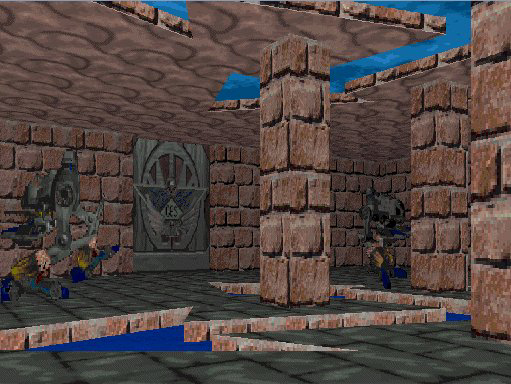
At the time, Jaimi was also working as a programmer for the local cable company. When they found out that he might leave, they made him a huge offer to stick around. That, coupled with his girlfriend’s urgings to ‘grow up and get a real job’, convinced Jaimi that he should stay away from the game industry. Who was I to argue? Well, I did argue regardless, but it didn’t do any good. I wasn’t his girlfriend, after all.
While we lost Jaimi and I continue to believe that he’s a smart guy, in hindsight it’s pretty obvious that it was a good turn for WoT. Can you imagine the fantasy fine art world come to life using a Frankenstein-beast hybrid of two low-tech engines sewn together? Me neither. Just compare a sample 4dx screenshot with a current WoT shot, and I think you’ll agree.
To sum up, the engine effort was floundering and I had radio silence from Jordan in response to the concept. Despite it all, I focused on the design.
Part III: Adventuring in Randland
Swordplay for the Rest of Us
Ever wonder what an adventure game would be like playing Rand in the Two Rivers area? Dealing with Nynaeve’s temper—in fact using it to solve a puzzle? Me too.
The challenge was to design an adventure game in a real-time 3D world, including puzzles that would take advantage of both real-time and 3D. And, on those topics, if my design seems naïve to you at any point, well, it probably was. Remember that this was my first foray into this kind of game. And this was way before King’s Quest ever thought of the idea!
I got quite far into the design process. The first section, The Two Rivers, was a large and detailed environment. It introduced most of the major characters and used them in some really cool puzzles. It kicked a lot of ass—but naturally, not everything adhered to Jordan’s plot. And the drift only worsened in Whitebridge, the second section.

On top of the story/puzzle content, I wanted to pursue another element in the adventure game design: an innovative combat system. Combat was based on sword-forms, kind of a martial art, in a third-person alternate interface (you remember those flowery named moves from the books, like Parting the Silk and Stones Falling Down the Mountain). You’d learn new forms as the game progressed. Much like a fighting game, you’d call on the sword forms like traditional moves/combos. The difference was that, in addition to pounding keys, you could pause the game and select the forms from a list. It’s the fighting game for the rest of us, an action sequence that could appeal to people who play adventure games, and that would draw heavily on Jordan’s sword-fighting descriptions.
Add the sword-forms to a cool weave-based magic system and the ability to visit Tel’aran’rhiod and you end up with a game with many of the elements that people have been asking for. So, fans should now understand that I didn’t eliminate these things from the final game design because I didn’t like them; they simply weren’t appropriate for the game we eventually made.
The Last Battle
The day came. Like a bolt from the blue, we received a fax from Jordan. He tried to find nice things to say about the concept and offered suggestions, but it boiled down to this: He didn’t like adventure games. He didn’t want his characters in the game. He didn’t want a retelling of the story that he was still working on.
That didn’t leave me with much.
In desperation, Bob Bates (Legend president) and I jetted off to chat with Jordan. I couldn’t even consider the possibility that all my work had been in vain. I can honestly say that I don’t remember being more nervous than before that meeting. Not only was I about to chat with Robert Jordan, but months of work hung in the balance.
On the plane trip there, I decided on a last-ditch ploy that I’d pull out if everything else went south: I’d propose to make the game into a portal stone world, a parallel universe that wouldn’t match the world of the books. I didn’t want to do this, because it would weaken the license, but I would have done almost anything to save the work.
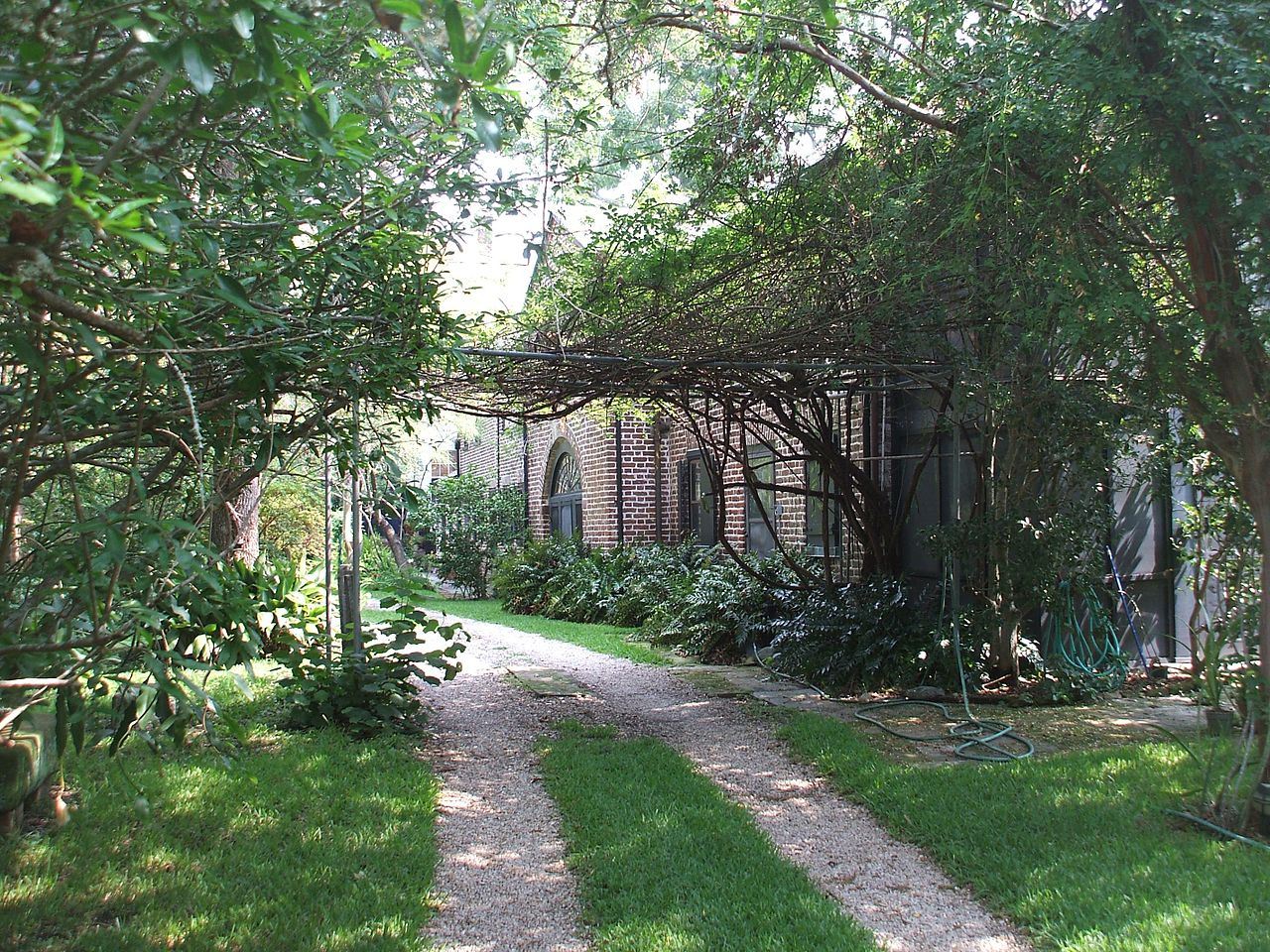
Our meeting with Jordan went surprisingly well. We spoke with Jordan, his wife, and a friend of his with aspirations of game designing. We described our positions, explaining why it was important to include the main characters, and how non-linearity was almost impossible in the adventure genre. I explained elements of my initial back-burnered design, saying that we could maybe pull something like that off as a sequel, as technology wasn’t ready for it yet.
The assembled company nodded and agreed. Even so, I still felt uneasy, so I pulled out the portal stone world card, just in case. On the plane ride back, I started to come to terms with it, experimenting with cinematic openings that would introduce the concept effectively.
Part IV: Back to the Beginning
The Fax of Doom
Shortly after we returned, Jordan sent what I vividly remember as the ‘Fax of Doom’. I was dumbfounded. We left an agreeable author and his nodding companions. We returned home to find that either we had completely misread them, or they had done some serious talking after our departure. This fax shot down the game completely. He didn’t give an iota on every single issue he presented.
The adventure game was dead. My months of work might as well have been a vacation. Now, I’ve never had a project actually canceled, so I can’t compare the feeling to it—but as a designer, this comes pretty damn close. And, as an adventure game company, Legend had effectively lost the Wheel of Time license.
But…
He wanted to know why we couldn’t make this game that I alluded to as a possible sequel, my back-burnered design.
Legend went into damage control. We acknowledged that we’d have to do something radical to save the license. So I suggested that we revisit my design. It gave Jordan exactly what he wanted. It offered a non-linear experience with a choice of player-characters (one of which was a woman); it had the potential to sell much better than any adventure game would; and it could be set in a time period that didn’t overlap the plot of the books.
I immediately dove back into the concept, trying like hell to retrofit it all into the WoT universe. It worked surprisingly well. I chose four different factions from Jordan’s world that represented good or evil, but none of them liked any of the others. They could spread their influence throughout society, an important part of the initial game design. The seals substituted the “treasures” of each faction easily.
I got excited. The disappointment of the canceled adventure game was blown away by the opportunity to realize my original inspiration. It was a mammoth game. It was overly ambitious. Technology was nowhere near what we would need it to be. But I had a mission.
Here is the result of that work, a concept document that described the new Wheel of Time.
While this document was valuable, it was clear that too much still existed in my mind that wasn’t represented on paper. In order to flesh out the moment-to-moment experience, and communicate that with others, I wrote an additional paper called the Experience Document. Click here to read it.
I liked this paper. It read like a story and quickly brought the audience into the world locked inside my head. Now it’s interesting to go back and compare that experience to what we were actually able to build: both what was obviously too ambitious for a first product, and what actually stayed. I think that it’s telling that most of the actual ter’angreal/artifacts used in the final game had their origins in this document.
RandomSoft
That was the name of the software-publishing arm of Random House. What kind of name is RandomSoft? Does that inspire confidence in the quality of the product? It sounds like the program you bought is the result of chaos theory at work: the antithesis of a well-designed and directed game. I don’t know. It struck me funny.
They didn’t much like the idea of the new WoT. They didn’t much like software publishing, to tell the truth. They certainly didn’t do it very well. Finally, they simply withdrew from Legend, taking their money with them. They kept their interest in the company, but they cast us adrift without any clue (or care) about if we’d survive.
We had no capital to make this game, or any other for that matter. And we had no publisher to publish the non-existent game that we had no money to produce. Bleak.
But if you put those two facts together, you have a possible solution. Legend had always self-published. Random House merely took over those responsibilities when they invested in Legend. Now, that slot was empty.
Legend became a development studio, one that could offer its services to any publisher. It might sound like an obvious move, but it was something very new to Legend, and very scary. Would a publisher demand creative control? Would they dedicate the money that the project needed? Would they be realistic about schedule? Could we even find a willing partner?
This last question was asked in an environment that was very developer-unfriendly. Publishing was a losing business. Many companies were going belly up, or merging with other publishers just to stay alive. The last of the Hollywood “stupid” money dried up just as we came onto the development scene. In fact, we were in a car on the way to BMG studios to do a pitch when we got a call informing us that the guy we were supposed to talk to was pulled into an emergency meeting. That meeting signaled the close of the company.
The remaining money was not only smart, but cynical—and had been burned before. It was very difficult to convince anyone to even consider a new out-of-house project, especially something this ambitious. We were lucky that Legend was an established game developer—newbies never even got in the door—but we had a lineage of adventure games behind us to fight. We were selling something new and different. It was something we believed in, but we had to convince them that we could pull it off.
I don’t know if I would have believed it either, especially after actually trying to build it.
Oh, by the way, Jordan approved the concept. Given the odds against the game ever seeing the light of day, it was almost anti-climactic.
Part V: Keeping it Real
Pay No Attention to the Man behind the Curtain
Words can only take you so far. To be honest, I think I did well presenting the concept, given how passionate I can be discussing something in which I believe so strongly. But pretty pictures are worth a boatload of words, especially to jaded producers who are looking for reasons not to be impressed with your pitch.
I gathered the artists that I had earmarked in my years of adventure game production, people I knew had the talent to bring my fantasy world to life. I had professional architects design the environments. I had fine artists paint the textures. And I had Hollywood character artists model the people and creatures. You might think that managing three teams of people to produce a handful of concept shots would be a cakewalk. Then again, maybe you have more foresight than I did.
It was tough, but the end-results were worth it. For the first time, I’m presenting all of the original concept shots from my pitch. They were so good, so convincing, that you might even see one or two floating about on various web-sites masquerading as actual shots from the game. I paid special attention to ensure that the pictures represented what could theoretically be generated with a then-cutting-edge 3D engine—no bump mapping, no filters, etc. These shots demonstrated that Legend could also produce incredible graphics, they gave people an actual glimpse at the world I carried in my mind, and they opened more doors than words ever would.
But they were smoke and mirrors. We still had no technology that could actually power such a game.
Pop the Hood
Things weren’t moving on the engine front, so I decided to go fishing. Freeware, shareware, and even commercially available engines usually fell flat when it came to actually making a product. The only success story was Raven’s relationship with id, and a few bizarre releases from Capstone using obviously immature versions of the BUILD engine—although you could hardly call the latter success stories. Hell, after playing TekWar and Witchhaven, I was convinced that Duke3D was going to blow chunks.
I looked at everything available at the time. It’s funny that, when you get close to actually releasing your product, people ask you why you’re not using the Quake X engine (or whatever engine has just been announced). The answer is that you make that decision at the beginning of the development cycle, not the end.
I looked at BUILD (and I asked about Prey, announced even then). I looked at Quake I (very, very new then). I looked at Uvision (one of the only companies that clearly didn’t take me seriously. They claimed that they had customers lined up around the block, and that I couldn’t possibly afford them. How many Uvision-powered games have you seen?) And then I read a small article about this new game in development called Unreal.

It looked good.
I gave Mark Rein a call and discussed the project. He didn’t blow me off, but he was understandably reserved. Given that words were worth only so much, I upped the ante and sent him the concept shots. He immediately emailed back a response that said approximately, “Holy shit! We’ve got to make this game with our engine!” along with an invitation to meet with Tim Sweeney to see the engine in its current form.
Mike Verdu (Chairman), Mark Poesch (Dir. of R&D), and I took the trek to Rockville. There we met up with Mark Rein and Tim. The meeting was a landmark for WoT. Mark R. had read through the concept and liked it, although he thought it should have more action. Tim really liked the artwork. In fact, while we all chatted, Tim was busy recreating one of the scenes in the then-current version of UnrealEd; he was that captivated. I also remember his excitement, showing off his new tech. It was clear what motivated this guy.
My Life as a Level Designer
We left with a current copy of the engine and editor, and with a mission to come up with a prototype. Back then, I had no level designers or programmers—just me and the editor; everyone else had been swallowed up by Callahan’s Cross-Time Saloon, one of the adventure game hold-overs from our Random House days (which we ended up publishing through Take 2).
I worked days and nights, wrestling to understand what made the editor tick, trying to get it to perform on my P50-or-something-like-it PoS. Every function seemed to take five minutes. It wasn’t until I upgraded to a state-of-the-art PPro 200 that I was able to make real progress.
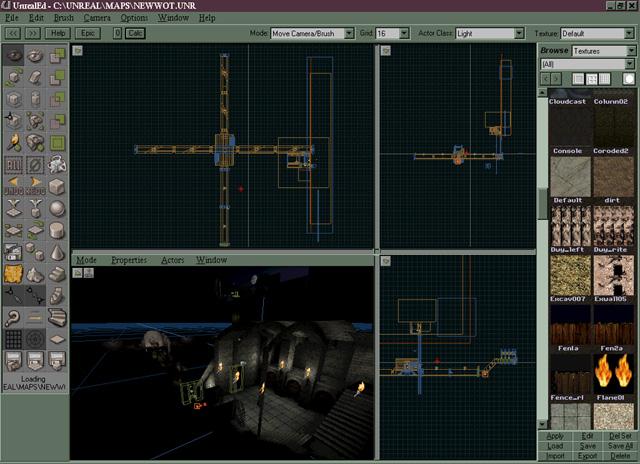
My job was to translate the scenes in the concept shots into the engine, then connect them with some believable architecture. I took the task literally. I’d stare at the original 3DStudio files on the screen, draw what I saw there onto graph paper, then recreate everything in the editor exactly. Painstaking. Agonizing. But effective.

I was able to apply many of the original 3DStudio materials as textures, along with some additional work from the artists. The end results were breathtaking. I couldn’t believe that these environments were being rendered in real-time. They looked just like the concept shots.
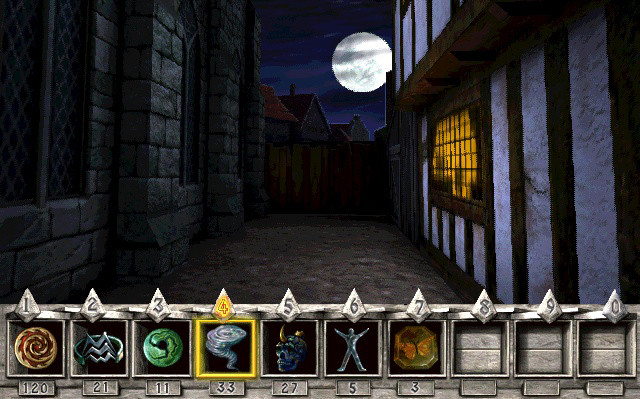
When we went back to Epic and showed our prototype to Tim, I remember his response exactly. He stared and said, “This is my engine?”
In an interview, Tim stated that this was the moment where he realized that engine licensing was a viable business. Other companies could take his technology and produce something new and unexpected. They could apply different kinds of talents to make games that complemented their own line.
Personally, I believe that this initial prototype, as well as our following work, significantly affected the landscape of 3D design. We proved that levels didn’t have to look like levels. They could recreate real-life architecture. They could be beautiful and functional. After that moment, things changed.
I told you that being a game designer brings its own conceit.
Part VI: Selling the Dream
Magic Game: For Sale/Sold
Only Terry Brooks fans will understand that header. The rest of you should just assume that I’m just unfathomable and witty, even if only one of them is true.
It was about this time that we adopted the “throw all the shit at the wall in hopes that something will stick” philosophy. That is: don’t worry about revealing secrets. Don’t concern yourself with holding back. Do everything you possibly can, and maybe something good will happen.

It was in this vein that I started WheelofTime.com. We had no game. We had no publisher. But we had a damn web site years before we could ever hope to release anything. Despite that, I contend that this web-site was another landmark event.
Because I had the bandwidth to devote to creating and maintaining a site from scratch, and because the net already held a horde of Jordan fans, we immediately attracted a lot of attention. I kept people up-to-date on anything that happened with the game. I wrote comedic columns. I slipped out scraps of information about the design and screenshots from the prototype. A community grew around the site, the idea of the game—a community that still exists to this day.
At the same time, we must have trucked our little sideshow to every publisher under the sun. And I carried that Ppro every step of the way—except the time that it got shipped to Denver when we were presenting to Williams in San Francisco. Weirdly enough, Williams ended up reacting very positively, even though we had to go through three of their machines to show the prototype and supporting shots.
We showed it to Broderbund, and I announced that I’d be staying there, just to play in their sand Volleyball courts. We showed it to Microsoft who wined us, dined us, and showed us The Other Side (a cool store-front MP action-game center). We showed it to Sony, to EA, to Virgin, and many many more.
And then we showed it to GT. Given GT’s natural interest in everything Unreal, we already had an ‘in’. But their purse-strings were tighter than waistbands on Thanksgiving. The budget they proposed would have created something that I affectionately call the ‘screaming baby’. Here’s the image (sensitive readers should skip to the next paragraph): a baby sits in the corner. That’s the game, since every designer thinks of his work as his beloved child. All of its limbs have been forcibly removed. Those are the features that the budget wouldn’t allow. He sits in that corner, atop his own filth, unable to move. And he screams to draw you into his world of misery. Once he’s got your attention, you’re lost.
As you might be able to tell, I was a little depressed by the prospect.
Activision was a slightly different story. They liked the game, but they didn’t want the license. In the spirit of the above-mentioned philosophy, I immediately worked up a WoT-less version of the concept. Given that I whipped it up in a matter of days, the backstory was surprisingly solid; in fact I’ve recently revisited it as a possibility for my next project. It’s not my current direction, but it still has a lot of potential.
Author’s note: At one point, I realized that this revised backstory didn’t want to be a game. It wanted to be a novel, and it became the inspiration for my soon-to-be-published novel: The Child of Chaos.
We presented the concept to a very positive reaction. They represented that it was a slam-dunk, and they only needed to run it through final approval. Although I was upset about losing the license, at least I’d be able to make my game with the money it deserved. At that point, I’d take what I could get.
About that time, I had broken up with my fiancée, someone I’d been with for 12 years. On top of that, the endless quest to sell this game had worn me down. I decided to do something I’d never done before: go on vacation alone. To Cancun. I figured I needed something different in my life.
The day before I left, I got a call from Mike Verdu. He told me that Activision had passed on the project. Evidently, their then-budding relationship with id was too important to risk funding a game that used the Unreal engine. I grabbed my suitcase and staggered to the plane in a daze.
The only real prospect left was the screaming baby.
Have a Fun Vacation!

I flew away to Club Med in Cancun, the first time I’d left the country. In fact, the reason I went there was that it was the only place I could go without a passport—just a birth certificate and driver’s license. When I arrived, I stayed in my little room for about an hour, staring at the walls.
But I’d spent the last few years worrying about selling this game, so I figured that no matter how dire the situation looked, I’d try to unwind. Unwind I did. For the next ten days, I played a lot of volleyball, I made new friends, I relaxed and read. It was the most incredible vacation I’d ever had.
The night before my plane back home, I played in a volleyball tournament. I had hand-picked all of my team-mates, and we won. This was especially satisfying because many of my comrades were short, and we played against some seven-foot monsters, but skill prevailed.
I planned to go to bed afterward to rest up for an early flight, but a new friend (who was also leaving the next day) convinced me to wash up and come to La Palapa, the local dance bar. This night is a story in itself (that I’ll write as a screenplay for an upcoming miniseries). There, I met Sabrina, a beautiful Italian woman who luckily spoke fluent English. She stole my heart and changed my life.
Part VII: Building a Microcosm
Once More into the Breach, Dear Friends
Apart from my budding romance with Sabrina, the following weeks were uninteresting. Eventually, we inked the deal with GT. Yes, it was the screaming baby deal, but at least it was a deal. After evangelizing this project for so long, making a fraction of my game was better than no game at all.
Now it was time to gather my team. I already had the art staff in mind, based on previous experience, but things don’t always work out as we expect. PanOptic, the crew of virtual architects that I depended on for my solid architectural foundation, was acquired by Virign. In a flash, one of the key selling points of the game just disappeared.
Frantically, I had every artist on the team try their hand at architectural design. It may have been luck or simply opportunity, but our only in-house artist at the time, Paul Mock, tapped into a real talent in 3D design. Unquestionably, he deserves much of the credit for the architectural style of the final product. He took all sorts of styles, meshed them together, and produced plans for the spaces that included exact measurements.

But someone had to implement these plans. Despite the fact that Legend had zero level designers, we weren’t too worried. Based on our successful experience directing art remotely, we figured that we could do the same with level design.
Big mistake. For a lot of reasons.
Level Design Recruitment for Dummies
First, level design was a very new field. Unlike art, people viewed it more as a hobby than a profession. Anyone willing to freelance was only going to do it in their spare time, because they were supporting themselves with another job. Therefore, you were automatically limiting a remote level designer’s productivity to his free time. And even if that person was amazingly productive, he was going to burn himself out, because that was the time that he used to apply to relaxing.
Second, the field was flooded with people who weren’t very good. It took months to wade through the hundreds of substandard submissions, trying to find anyone who fit our qualifications. Even when someone was given a chance, quality control was very difficult when the level designer was off-site.
Third, we were attempting to create a type of game that hadn’t been done before. Communicating the design expectations through email, icq, and occasional phone calls led to lots of crossed wires, which led to frustration on both sides.
Fourth, we were trying to get level designers to create environments with a game in mind that didn’t exist. They couldn’t place monsters. They had no AI. There were no weapons. It was all still hypothetical, which meant that there was no way to test anything they built.
Fifth, trying to keep a team of people spread throughout the world synched with the latest version of a build, originating not just from us but from Epic, was impossible. The phone bills alone were killing the people overseas.
And finally, if we did find someone talented and motivated, chances are that he wanted to make it his profession—but I didn’t have the money or mandate to actually hire anyone. People who really wanted to work with us ended up going elsewhere, to companies that could actually offer them jobs.
Add to this the then-immature technology of Unreal and associated tools that were flaky at best, and you can understand why we went through level designers like water. The early recruits read like a list of who’s who in Internet level design at the time. They included Charlie Weiderhold (now at 3DRealms), Matt Sefton (a noted Quake designer), Matt Worch (who went to Ritual before coming back to Legend), Andrew Smith (yes, the same Andy Smith who seems to revel in controversy), Warren Marshall (who also came to work full time at Legend after initially leaving the project), and Aaron Logue (a.k.a Gyro Gearloose), along with many others.
Interestingly, this actually worked to our benefit in promoting the product. These people were opinion leaders in the level design community. After they’d perused the design material, they became converts, and they communicated that excitement to their peers.
The Microcosm
Understandably, GT wanted to see a prototype: an example of the intended game play. It would, hopefully, prove out the design while also serving as a marketing tool. It was unquestionably the right thing to do, and it revealed a lot of problems with the process of making the game.
Of all the original level designers, only one was truly successful working off-site: Aaron Logue. And he hated working with the early Unreal Editor (which was notorious for crashing often and unexpectedly). In fact, he despised it so much, that he wrote a utility that would convert maps created with Quest (his favorite Quake editor) into .t3d (ASCII Unreal) format. It was cumbersome. It didn’t support lighting or textures or movers. But it worked…
…kind of. The fact that his tool didn’t support textures or lights or movers meant that someone had to go in and add those elements every time the geometry changed. Eventually, Aaron modified his utilities to support some of these elements—but for a long while, the texture artists had to place, replace, and replace very precisely shaped textures into the environments. The entire team lost considerable time redoing work that could have been saved had UnrealEd been more stable.
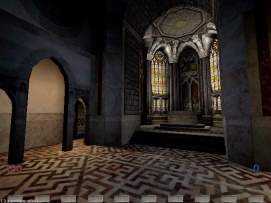
Working closely and tirelessly with Paul Mock and Cindy Wentzell, Aaron constructed what we referred to as Amador, the initial Whitecloak primitives. Of everything we made during this time, the Whitecloak primitives were virtually the only assets to survive into the final release. They did what they had to: they proved that the concept of primitives and our process of level construction and art direction could work, and the results were extraordinary.
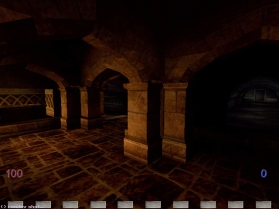
Aaron burned out. He had a full-time job as a programmer elsewhere. WoT devastated his free time and significantly decreased his sleep schedule. Although he toiled like a trooper to finish the prototype, he told me even before it was finished that he couldn’t take any more.
The only guy who proved that it was possible to build what I saw in my head went away. As far as level designers were concerned, I was back to square one.
The technical end wasn’t faring much better. Everyone knew that the design was ambitious, yet only two and a half programmers were carrying the load. We had unfinished engine technology with limited documentation, an emerging script language, many missing features, and unplayable network code. The engine was also changing rapidly, pacing Unreal’s development. This was a hard time to be a licensee.
The Microcosm was supposed to show a full-up multi-player game in action, but the results were far from that. Trying to master the immature Unreal technology on top of implementing the fundamentals of WoT’s design was too much for the tech team in the time that our milestones allowed. The expectations for our prototype were down-scoped (a tale to become very familiar in the further development of the project).
We delivered a prototype, but many of the important questions about the game could not be answered until much, much later. The Microcosm’s multi-player experience was more a fight with the technology and implementation than a test of the design.
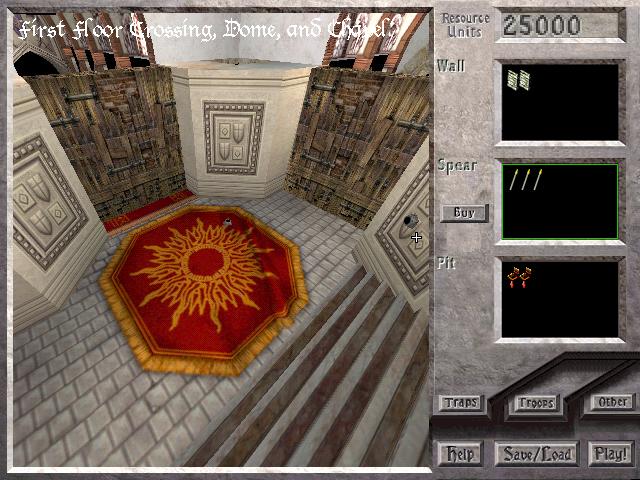
Much of what was implemented did make an effective single-player demonstration, however. The environments inside the Whitecloak’s fortress were stunning. The citadel editor (non-networked) was impressive. The initial AI programming gave the impression of great things to come. Artifact effects had a lot of promise. The work looked like a foundation upon which we could build a game.
This demonstration delivered enough to convince GT that this product had promise. They signed up for the full deal.
Happily Ever After…
…which brings us to the end of this tale. (Author’s note: not really).
If you’ve made it this far, I’m sure you still have questions about how the game itself went from a rickety prototype to the box sitting on your shelf, but the rest of the story would be at least as long as what I’ve written.
In short, WoT’s development was rocky, but if what I read in Game Developer’s post-mortem articles is true, there are few projects that run like well-oiled machines. In WoT’s case, on top of the miracle it requires to actually release any product, there was no way to realize the game that I originally envisioned. There were too many lessons to learn, too many mistakes to make. We wanted to build a revolutionary game, and we started with virtually no team, no experience in the genre, no budget, and no technology. That’s quite a bit to overcome on a finite schedule.
While the end result bears only a surface resemblance to the dream with which I started this journey, and the game continues to struggle to become recognized in the marketplace (which has much to do with factors apart from the game’s development), in my eyes The Wheel of Time is unquestionably a triumph. WoT owes much to Legend’s acquisition by GT (changing the project from an externally developed game to an internal product, which made a world of difference), but it owes much more to the extraordinary efforts of the very dedicated team.
To me, The Wheel of Time’s more obvious successes are very apparent:
- The environments are some of the most beautiful ever seen in a game of its kind, hands down. We truly brought Jordan’s books to life.
- The story is one of the deepest that FPS games had ever seen. Many feel that it does credit to the source material (high praise indeed).
- The design added strategy to the traditional run-and-gun dynamic of Quake. Offense and defense were suddenly a major part of the experience.
- The citadel game allowed players to affect their environments, to invest themselves in the game by customizing their home fortresses.
WoT was a pioneer. Unquestionably, the original design was too much so. But even what remained in the final product walked the genre ahead a bit; of the last two points, I’m positive you’ll see future products that expand on those ideas.
In addition, I’m personally very proud of the community that continues to support this game. To know that my screaming baby quieted down a bit and spoke to people, made a real connection—this made it all worthwhile.
Author's note: This is where I originally ended the article, but I actually wrote more. For the first time, here are the additional lost sections.
Part VIII: Running to Ground
Twenty seconds to impact…
We moved into the development of the full project. We established milestones that, we thought, should be reasonable. In fact, the milestones only required a subset of the assets and features we intended to fit into the final game. Given our experience with the prototype, we figured it was safer to only count on something much smaller.
This was more correct than we knew.
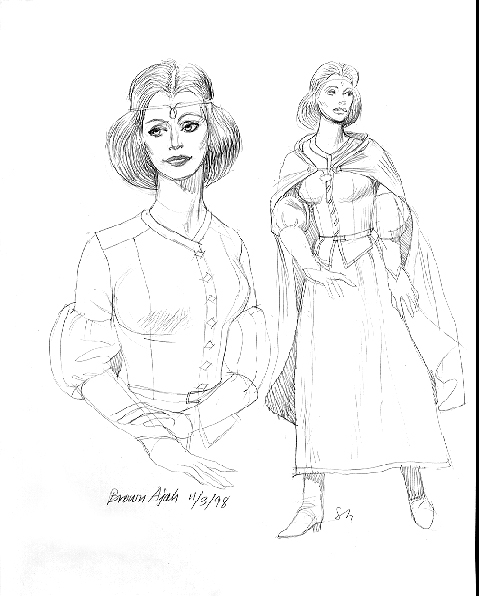
Each milestone was a struggle. We front-loaded them with assets derived from off-site—character models, music, sound effects, and maps (still relying on off-site level designers)—because technical development was so slow. But it was hard to generate assets fast enough to feed the milestone beast, and many of these assets were created without the technology to support them. Maps were still being built in a tech vacuum. Animation scripts didn’t have the AI to play them. We were front-loading the project with material we might not be able to use anyway.
The pressure was terrific. It was hard to envision what this project would look like at the end of the impossible schedule that we’d signed up for, given the rate we were moving. It was hard to envision that we’d have anything by then. And for my part, I have to admit that I wore blinders. I wanted to make the original game so badly that I kept fighting for the initial design. But the signs were everywhere that this game was in deep trouble.
And that’s when the tech lead quit, which left one newbie programmer and half-time of Mark Poesch on the technical team. I was terrified.
Tell Me a Story (Fifteen seconds to impact…)
New technical people from inside Legend had been unavailable from the start, either because they were dedicated to other projects or because of WoT’s tight budget. So in addition to my search for art and level talent, I immediately started recruiting programmers.
I also did some serious thinking about the design. Technically, it seemed to me that we had proven we could create a decent single-player game. And I had been worried from the start about getting the AI-bots sophisticated enough to replace a player character, which was what the original design relied upon for a single-player experience. The now-missing tech lead had been responsible for our AI.
Add these things to the expectations of the book fans. They would want a compelling story that was faithful to the series. The current design was about an experience, not a story, and it was more concerned with ensuring that the game was fun than coloring within the lines of the license.
And, let’s face it: I’m an adventure game designer. Why would I not want to write a story?
I changed the direction of the project. I sliced away major elements of the multi-player dynamic, especially anything that seemed risky from a technology standpoint. Autonomous non-player characters? Gone. Dynamically linked world levels that connected the customized citadels? History. Quests to recover artifacts? No more. The multi-player game would be much simpler. It would still maintain what I felt were two of the three design pillars: strategic spell combat with lots of offensive and defensive artifacts, and customizable home bases or citadels. Perhaps they would be enough.

In their places, I started designing a single-player story—actually, two of them: that of the Amyrlin Seat (the leader of the White Tower, and the only really “good” character) and that of Ishamael, the Forsaken (the unreservedly “evil” character) to contrast. They would introduce the other characters and the world, explain why things might be different from the books, and reveal the player-character’s motivations behind the multi-player dynamic. I had my work cut out for me.
At about this time, I took a trip to Italy to see Sabrina. It was my second overseas journey; I was making good use of my new passport. The flight was about ten hours. Eventually, the lights went out and most people went to sleep. The two people sitting next to me were even nice enough to give me a sedative, but all it did was make me a little fuzzy. Then, in the middle of the “night”, I figured it out.

I suddenly knew Elayna’s story. I realized that the Hound would be created during this tale. And he wouldn’t steal a seal from the Tower as I originally thought, but instead a mysterious artifact that was once used to shield Elayna’s abilities, which also could also be used to shield Ishamael at the end. This was why neither of these characters could channel.
More of the story flooded into my brain, but as much as I liked it, the quantity only worried me more. You see, I had no paper, no pen. I could not write any of this down, and I was afraid that if I slept, I’d forget it. I sat there for hours, running through the story in my mind, locking it down and trying to prevent any of it from escaping. When my neighbor woke up, I calmly asked him for a pen and, when he handed one over, I found some napkins and scribbled for ten minutes. He gave me the strangest look when I handed the pen back to him.
I had my story.
Of course, it wasn’t fully formed. When I fleshed it out, I ended up with quite a monster. Here, for the first time, is the document that describes Elayna’s original tale. You’ll notice a lot of similarities to the final, but you’ll also find quite a lot simply disappeared. And note the complete lack of the Whitecloaks from this tale. They were intended as a foil for the Forsaken in his story.
Ten Seconds to Impact…
Around this time, Mark Poesch had taken over for our missing tech lead. He was fielding the technical résumés sent in response to a notice on WoT.com and looking hard at the technical viability of the project.
We were forced to admit that a project of this magnitude required a majority of in-house people, including artists and level designers. Epic ran headlong into this realization when they dragged their entire development crew to Canada for a year to finish Unreal. Many of our original free-lance texture artists liked the idea of working for Legend. Robert Wisnewski, Cindy Wentzell, Julie Aroldi, and Marc Tetrault all joined us full-time. And thank God.
I found an American lad hanging out in Japan, name of Scott Dalton, who quickly became the most motivated and productive level designer to date. The first chance I had, I brought him in-house. James Parkman, a survivor of a failing game developer in Texas, joined him a little later. And finally, Warren Marshall reappeared out of nowhere (well, Canada) to join us on-site.
I suddenly had a talented in-house art and level design team. Things were looking up.
Five seconds to Impact…
Given the state of the multi-player technology, I decided to focus the art/level design team on the single-player assets. We were still building MP maps to meet the milestones, but without the technology to test them, we had no idea if they’d be any good.
But even with the increased manpower, it was clear that the project was still too big. I normally err on the side of wanting to design too large, to build too much (I suspect that I share that trait with many designers), but I realized that we were having trouble building even one single-player story plus the multi-player maps. There was no way that we could handle the Forsaken’s tale as well.
Despite some management resistance to the cut (it was a cool idea to show two perspectives on the same story, one good and one evil), it was rather painless. I hadn’t written the second story, and I knew that building it would be quite impossible. Elayna was on her own.
Mark found a few talented folk out of the pile of résumés, and from them we hired Mike Fox and Aaron Leiby, two very sharp guys. We had also been shanghaiing other tech folk from inside Legend, despite the budget implications.
We finally had a technical staff.
Too little, too late.
Impact
I didn’t even see it coming, although I should have. We had signed up for an impossible schedule, even if everything went perfectly. Everything did not go perfectly. We were less than a year away from our planned release, and we only now had gathered the team to build the game. Without a miracle, we would end up with lots of interesting pieces of a game scattered everywhere on the day we intended to ship.
I was called into a meeting with Mark Poesch and Mike Verdu. There, they laid out the new world order: this game was going to be multi-player only. We would kill the single-player storyline entirely; what remained would be a simple series of tiny tutorials to introduce the player to the MP experience—a new, cut-down MP experience. As far as that went, we would make what we could with the time that remained. It would be modular, so that we could chuck anything out of the design that we didn’t have the time to build (this was the major failing of the single-player storyline; it imposed a rigid structure that made cutting sections of it difficult).
This new game wasn’t anything like what had inspired me so long ago. It was a quick hack-job, intended to get something shipped by the deadline. It completely ignored the license. It dismissed any pretense that original and inspired design is important to shipping a game.
But it was technically achievable. It took the safe route and produced a game that we knew we’d be able to ship on time and on budget.
It was an abomination.
But that didn’t mean that we had any choice.
I had a dilemma. I couldn’t sign up for this game, because I didn’t believe in it—and yet I acknowledged that we needed a plan to get us something we could ship.
I told them that I’d try to come up with a descoped version of what was already on the table, something that didn’t kill the single-player game. If we did kill it, I maintained, we’d be throwing away one of Legend’s strongest proven talents: the ability to tell a compelling story. What’s more, we’d be actively working against the license. Given the game’s history, and the fact that my continual attempts to cut the game still left something that was too big to build, they were skeptical of taking any other route than the obvious, drastic approach.
But Mike Verdu, the man who walked with me every step of the way to sell and build this game, gave me the benefit of the doubt, and I went off to do more cutting. If I could come up with a plan that used the resources we had in the time we had left, we would build it.
Part IX: Making Movies
The Basic Conflict
The conflict between realizing a sound design and building something we could ship haunted this project to the end. In one corner, I wanted to do anything possible to make the game into something we’d be proud of, something that would do justice to the license. In the other corner, Mark had the mandate to make sure we shipped something by the deadline. The meeting described in the previous section simply made the problem more evident, but it didn’t solve it. It became increasingly difficult to reconcile the two positions.
I did work hard to cut down the game. In fact, one clear idea came out of that meeting: move all storytelling from the game into cut scenes. The idea of interactive characters completely died, along with the dialog system they rode in on. This would cost more money in the long run, but we could off-load the effort to someone outside of Legend, so that they could make the cinematics in parallel.
I dove into the task. At last, there was something I could sink my teeth into, instead of worrying about production problems and recruitment headaches. I wrote the scripts in a surprisingly short time, but although I was proud of their quality, they were predictably huge. This was going to be expensive.
Unfortunately, the screaming baby had little patience doling out money for movies.
Making the Scene
I got a budget from GT, but it was almost laughable. In fact, when I went looking for animation studios with this figure and my massive script, most did laugh at me. I ended up with the lowest bidder and crossed fingers.
This company had experience with in-game cinematics, but the quality of their work was marginal. However, they showed potential, so I prayed that I could coax better work out of them (something that I’ve been able to do with others in the past). I had little choice. They were the only company willing to work with the money I had.
One factor in their bid was that they would not be creating new assets. The cut scenes would include only models and sets produced for the game. This caused a problem; although the character models were native to 3DStudio Max, all of the environments were built with UnrealEd. There was currently no method to transfer Unreal maps to 3DStudio, and no work could be done without it.
Because I had no budget for new tech, I searched for an inexpensive source for such a tool, combing the net for people interested and talented enough to make it. For a while, I even had people working in parallel, hoping that at least one attempt would be successful. None of them panned out, and the time spent waiting was forever lost; this hurt the cut scene schedule.
Finally, I convinced the animation studio to make it themselves. One of their founders was a programmer, albeit a reluctant one. He made the utility and saved the day, a short-lived moment of glory for this company.
Now they could start animating, and they did. I found out why they were the lowest bidder; you get what you pay for.
The new material was no more than mediocre at its best, and they were slow in producing it. So at the same time, they were slipping behind their own schedule. Their low bid gave them little margin for error, so I tried to help.
At first, I thought that I would try to make the job a little easier for them. Instead of a full-up animated intro, we’d present a slideshow of stills accompanied by narration. I even went so far as to produce these stills in-house.
As time wore on, it became clear that they were in deeper trouble than could be helped with a slide-show Band-Aid. They were slipping farther behind schedule, and the animation deliveries were progressively more depressing.
The cut scenes were supposed to carry the story. They were the vehicle that needed to reach the fans of the license. If they weren’t made well, no one would even hear the characters’ lines; they be too busy laughing at the animation. And I had over an hour of these scenes. That’s a long time to cringe at bad cinematics.
These guys needed professional help, but we couldn’t afford it. Where were social services when I needed them?
Are You Ready for a Good Time?
Did you know that GT stands for ‘Good Time’? Believe it or not.
Speaking of publishers, remember Random House? They might have become a silent partner, but they hadn’t disappeared. In fact, because of their financial interest in Legend, they could have struck at any time like an angry cobra and regained control of the company. This was unsettling.
Although the picture I paint of the development of WoT is somewhat negative, remember that I’m focusing on the problems. In this time, we had achieved more with the Unreal engine than any other licensee. Our artwork was unprecedented. The builds that we delivered to GT were frequently the highlight of the internal Product Evaluation Group meetings. We were actually doing quite a number of things right, and we were a little worried that Random House might turn their attention back to us.
GT, our publisher, was expanding. They had purchased development houses before, and the financial model that Legend represented was appealing. Random House was open to the sale, and we were very interested in gaining the solid financial backing of a company whose primary interest was in making and selling games.
Bottom line: GT acquired Legend.
This was another landmark event. Suddenly, GT changed from a publisher holding a development contract to a parent company. We no longer had to battle from milestone to milestone to make payroll. In fact, GT’s purse strings suddenly weren’t so tight. They didn’t open the floodgates, but they clearly saw a difference between the strict budget of an externally developed product and that of one made by an inside studio. They were more willing to invest time and money in a product that they truly owned.
Although it remained an uphill battle until the end to make this product, this event gave WoT the margin it absolutely required to be completed.
Shut that Kid Up!
I can’t really explain what it’s like to manage a game with an unrealistically low budget (yes I can; remember the screaming baby?). The trade-offs are more painful than you can believe. If you’ve designed something slightly more complex than minesweeper and you therefore find yourself over budget, here are your options:
- Toss features. All resources and assets associated with those features suddenly disappear and don’t cost you anything.
- Kill assets. Your bestiary of fifty monsters just became fifteen. Less models, less animation, less money. As the limit in this equation approaches zero, you find that you’re already done!
- Find cheaper outside sources. This either means that you’re convincing a talented freelancer to work for less than he’s worth, or you’re working with someone who isn’t so talented, and therefore cheaper.
- Accelerate the schedule. The less time people are working, especially those who are in-house and fixed-price, the less you pay them.
- Hold your breath until upper management gives you more money. This doesn’t work. After you pass out, they just take turns kicking you.
I’d been following this formula my entire career at Legend (I only got kicked once; that was enough). I’d always design big, then slowly slice away at the game to fit it into a budget that wouldn’t buy a decent house. This time, shaving the game down was not only painful, but it also didn’t look like it would work. Until this moment, the only real alternative that seemed like it would fit in the budget and schedule was the multi-player hack-job. With Legend’s acquisition, we had the chance to build something a little closer to what the game should be.
A smidgen more money and time clutched tightly in my fist, I turned my sites to the problem currently on the table: the cut scenes.
With a Name Like Spankhole, It’s Gotta Be Good!
One of the animation houses with whom I had chatted earlier was Blur Studios. Tim Miller, the president, and I had spoken at length about figuring out a way to make the project work for them. He came back with creative ways to fit the story into a smaller overall package—mostly with narrative—but in the end, I didn’t want to sacrifice the immediacy of the story’s action, which is why I went with the alternative.

Blur was talented; they had a sterling reputation and a list of credits a mile long, both in games and movies. On top of that, they seemed like a great group, and Tim and I really wanted to work together. But in the end, he couldn’t justify it financially.
Now, I had a bit of money to get professional help for the B-team, and Tim was the obvious choice.
I called Tim with a plan to offload a fair chunk of work to relieve the pressure on the original crew. Blur would take over the production of the intro (a real one, not a slide show), as well as the first and last cut scene. This would front load the top-quality cinematics, and give the players something special when they finished the game.

When the first animatics showed up (a primitive blocked-out version of the script), I was floored by the difference between their work and that done by the original contractor. Blur’s characters understood the lines they were delivering. They were acting instead of standing and waving their hands randomly.
Then another CD arrived from the original contractors. In addition to the unsurprisingly low quality, I discovered something strange: Elayna wasn’t wearing her cloak in any of the scenes. I thought it might be a detail that they intended to add to the finals, but when asked about the problem, they stated that the cloak was removed because it was too difficult to animate.
What?
This was a significant consistency problem, because the player model is wearing the cloak everywhere inside of the game (something that took a lot of pain and effort on the part of Steve Bodnar, the in-game animator). It was an important part of her character. I told them to get the cloak in. Their response was that, because of their tight budget, they needed extra money to animate the cloak, an amount that was almost half the original budget. Not that they had time for it anyway.
That was it. I’d had enough. But I still didn’t have enough money to have a name studio reanimate everything.
Tim mentioned that there were a couple of young animators making a start of it inside of Blur’s own building. They had the unfortunate name of Spankhole Studios (although Scott Dalton was so taken with the name that he stated that we had to get it into the credits somehow). They showed me some work that they’d done for a couple of other products. It was good, but rough. Again, it had potential.
I thought they might be able to help clean up the original work, get it a little more presentable. It was kind of like throwing a sloppy drunk into a shower, pouring some coffee down his throat, and cleaning his clothes, then hoping that he doesn’t embarrass himself when he stumbles back out on the street. Tim himself volunteered to help direct the process from that end.
The Spankhole boys were young. They were hungry. And, as it turns out, they were very talented.
It didn’t take long for them to throw out all of the original work; their experiments in fixing the existing stuff only led to inferior animation that actually took more time to produce. While the end results of their efforts can’t compete against something from Final Fantasy VII or some of Blizzard’s new stuff, here’s what they brought to the party:
- They animated almost an hour of cinematics from scratch.
- They added moving mouths synched with the speech track. The original work’s lip-synch technology changed the character’s face texture map—a process that the first animation crew felt was a competitive advantage. It not only looked bad, it kept the camera from getting close, where you’d really see that jaws weren’t moving. Spankhole’s work looked much more natural, and was less dramatically limited because the camera could go anywhere.
- They applied an understanding of cinema, acting, and camera work. They completely reblocked every scene.
- Every special effect was redone, and many new ones were added.
- They boned and animated Elayna’s cloak in every appropriate scene.
- They finished and delivered everything on an extremely difficult and tight schedule.
And here’s the kicker…
- They did all of this for less money than the original crew asked to go back and add the damn cloak.
Sometimes you get a lot more than you pay for.
There’s no doubt in my mind: Blur and Spankhole rescued the presentation of WoT’s story.
Here is the result of all of that work.
And while I wrote the header for the next section (Spreading the Wealth), I never returned to write any more. Honestly, the sheer quantity was probably more than enough. And if you read this far, congratulations. I hope you enjoyed the journey.
It certainly brought back a lot of memories for me.
Please let me know what you thought of it all in feedback.
Oh, and if you made it here, you deserve a treat. For everyone who sat through the entire credits, they were rewarded with the Wheel of Time dance party. Here it is.

